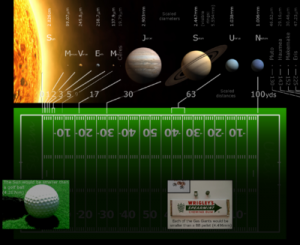 While out walking a few weeks ago I was intercepted by a couple of young clean-cut chaps wearing suits and a sugar smile that instantly screamed “Mormon missionary” from at least 500 yards. I’ll not bore you with the conversation, it was, as you might expect, very predictable. For me it was perhaps entertaining, but for them I guess I was a bit of a nightmare, and so it resulted in their rather rapid departure.
While out walking a few weeks ago I was intercepted by a couple of young clean-cut chaps wearing suits and a sugar smile that instantly screamed “Mormon missionary” from at least 500 yards. I’ll not bore you with the conversation, it was, as you might expect, very predictable. For me it was perhaps entertaining, but for them I guess I was a bit of a nightmare, and so it resulted in their rather rapid departure.
The usual cards were played, but one of them was a variation of one I’d not come across before (perhaps I don’t get out enough). Essentially it was a design argument, the quick summary is, “Look at X, it was obviously designed and so there you have proof that my specific god concept did it” (What can one do except roll ones eyes). There are two flaws in this :
Generally the “It was obviously designed” is a claim that is an appeal to ignorance and is saying, “I have no clue how this could have happened naturally”. This of course is the same palaeolithic thinking that motivated our ancestors to think that the sun, moon, and weather were all caused by gods.
Even if you could establish a design claim, and nobody ever has, at best it is deism. The leap to a specific god is (if you will forgive the word) a leap of faith and cannot be justified. Funny how the claimants specific god always turns out to be just the right one.
Anyway, what I was presented with on this occasion was the Titius-Bode Law. They did not know that term and were not familiar with it, but that is what it was. What they actually claimed was that the spacing of the planets within the solar system is too consistent to be random and so it must have been designed that way, hence god is real.
The Titius-Bode Law is an observation first made in the 1700s that the spacing of the planets within the solar system appears to follow a numerical sequence … hence the design claim. You start with the sequence 0, 3, 6, 12 etc, where each number after the 3 is double its predecessor Add 4 to each and divide by 10 to arrive at 0.4, 0.7, 1.0, 1.6, 2.8, 5.2, 10.0, etc. To within 5% or so, these correspond with the distances of the known planets back in the 1700s when expressed in astronomical units (AU), the unit of the Earth’s average distance from the Sun. Mars sits at almost 1.6AU and Jupiter at 5.2AU.
It all dates back to 1772, when a chap called Johann Elert Bode, published his astronomical compendium Anleitung zur Kenntniss des gestirnten Himmels. In it was the following footnote, initially unsourced, but was credited to Johann Daniel Titius in later versions:
This latter point seems in particular to follow from the astonishing relation which the known six planets observe in their distances from the Sun. Let the distance from the Sun to Saturn be taken as 100, then Mercury is separated by 4 such parts from the Sun. Venus is 4+3=7. The Earth 4+6=10. Mars 4+12=16. Now comes a gap in this so orderly progression. After Mars there follows a space of 4+24=28 parts, in which no planet has yet been seen. Can one believe that the Founder of the universe had left this space empty? Certainly not. From here we come to the distance of Jupiter by 4+48=52 parts, and finally to that of Saturn by 4+96=100 parts.
This fitted in very well with all the known planets at that time — Mercury through Saturn — with a gap between the fourth and fifth planets. Then came the discovery of Uranus in 1781 – it also fitted neatly into the series. Based on this discovery, Bode urged a search for a fifth planet. Ceres, the largest object in the asteroid belt, was found at Bode’s predicted position in 1801, so Bode’s law was then widely accepted until Neptune was discovered in 1846 and found not to satisfy Bode’s law, so that more or less scuppered the idea.
So what is really going on here?
There is no solid explanation of the Titius–Bode law, but if there is one it is most probably something to do with orbital resonance. Not all agree, some astrophysicists feel that it is simply a coincidence.
 If it is indeed just a coincidence, then it is explained by the amazing pattern recognition engine sitting between our ears that enables us to rapidly distil patterns out of chaos. It will however not only enable us to see patterns that are actually there, but will also often result in us seeing patterns that are not real. The word used to describe this is “Pareidolia“, and to illustrate that take a look at the picture here. You can clearly see a face but you know there is no actual face, and that what you are seeing is not real. It was not even designed to be a face, it is simply a coincidence.
If it is indeed just a coincidence, then it is explained by the amazing pattern recognition engine sitting between our ears that enables us to rapidly distil patterns out of chaos. It will however not only enable us to see patterns that are actually there, but will also often result in us seeing patterns that are not real. The word used to describe this is “Pareidolia“, and to illustrate that take a look at the picture here. You can clearly see a face but you know there is no actual face, and that what you are seeing is not real. It was not even designed to be a face, it is simply a coincidence.
Looking at the solar system and claiming that a mathematical pattern is evidence of a designer, when it only works for some of the planets and not all, is about as credible as looking at a map of the world, observing that Italy is shaped like a boot, and then claiming this to be a miracle because I just happen to be wearing shoes manufactured in Italy.
“the real thing that physics tell us about the universe is that it’s big, rare event happens all the time” – Lawrence M. Krauss, theoretical physicist